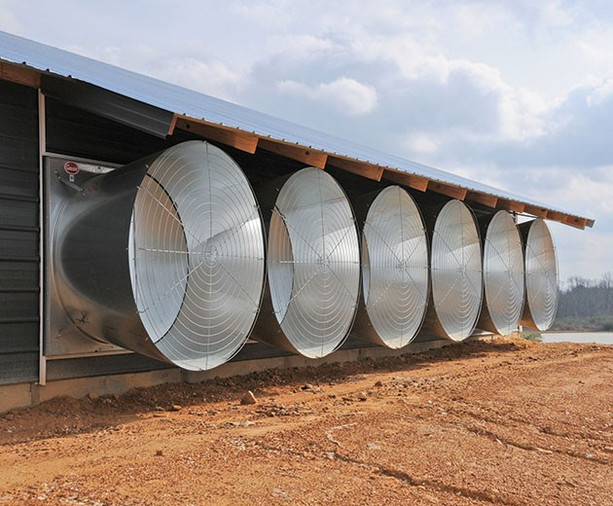Tunnel Ventilation Systems vs Conventional Cooling in Poultry Houses
Aug 25, 2022
Heat stress is a major concern for poultry producers in areas of the country that experience high temperatures. Recent heat waves across the U.S. have further highlighted the need for effective cooling systems when ambient temperatures reach 90+ degrees Fahrenheit.
One of the most researched and proven systems of poultry house cooling is tunnel ventilation. In this article, we compare tunnel ventilation with conventional poultry house cooling.
What Are Tunnel Ventilation Systems For Poultry
Conventional broiler houses rely on air inlets, curtains, and circulating fans to help cool the flock during hot weather. In the warmest climates, foggers may be used to improve cooling via evaporation. While these systems get the job done, they have significant drawbacks:
●Air flow may be limited and unevenly distributed, reducing the wind chill effects of fans.
●If air exchange rates are inadequate, ammonia and moisture builds up, raising health concerns for poultry.
●The use of foggers in conventional broilers is a problem when water does not fully evaporate from the floor, resulting in additional moisture.
Tunnel ventilation relies on creating a lower air pressure system inside the poultry house by using large exhaust fans to pull air through inlets located on the opposite side of the structure.
In essence, this ventilation system creates a wind tunnel, pushing air in one side of the poultry house and out the opposite direction. The directed, higher air flow volume of tunnel ventilation results in several advantages over conventional cooling methods.
Time To Upgrade Your Broiler House Ventilation?
Learn more about Farmer Boy’s construction services
Reduction In Poultry Flock Mortality vs Traditional Systems
Tunnel Ventilation Is More Efficient In Cooling Poultry Houses
When grouped together in larger numbers, poultry generate a significant amount of heat. Coupled with high outdoor temperatures, heat stress can lead to high mortality levels among the flock.
Traditional broiler house ventilation can be inadequate in many parts of the country that experience extreme heat. Tunnel ventilation is much more effective in cooling poultry due to increased wind chill performance.
One study found tunnel ventilation reduced house temperatures by 7 to 12 degrees Fahrenheit — a marked improvement over the 2 to 4 degrees achieved by conventional ventilation.
Improved Ventilation Reduces Moisture And Gasses
Another concern in large broilers is moisture and ammonia produced by the flock. High levels of both can cause distress and disease, leading to further mortality.
Poultry tunnel ventilation systems produce a higher indoor/outdoor air exchange rate than conventional systems. This means moist air and ammonia are more easily pushed out of the house via larger, more numerous exhaust fans.
Lower Poultry House Heating Costs vs Insulated Curtains
In general, heating costs can be lower for tunnel poultry houses than conventional broilers. During the winter months, cooling is less of a concern, but ventilation is still necessary to reduce moisture and to exhaust air pollutants like dust and ammonia.
Traditional broiler ventilation, including side inlets, ridge vents, and curtains, will occasionally need to be opened for proper air exchange. However, these systems have a low insulation value. For example, insulated curtains have an average R-value of 4-6.
By comparison, tunnel ventilated poultry houses require an airtight structure. Curtains and sidewall inlets result in suboptimal air flow. This means a tunnel ventilated house can be built with standard walls: a 6 inch thick wall with standard insulation has an R-value of at least 19. As a result, less heat may be lost in houses designed with a tunnel ventilation system.
Greater Cooling Versatility vs Traditional Systems
Tunnel ventilation systems allow for additional options over conventional cooling. Because of their directed design, tunnel ventilated poultry houses work exceptionally well with evaporative cooling systems.
Cooling cell systems can be installed in front of air inlets, further cooling outside air for lower temperatures inside the poultry barn. This is especially useful in parts of the country with high outdoor temperatures and low humidity, including states in the South West.
Tunnel ventilated broilers are also more efficient in conjunction with misters and foggers than conventional cooling. Circulating fans and passive air flow from inlets may be inadequate for fully evaporating water from a poultry house fogging system.
Note - Cool cell should not be used without ample air flow, humity can cause over heating even at lower temperatures without air movement.
Prevents More Floor Moisture Than Circulating Fans
Floor moisture is a biosecurity concern in broilers. Fogging systems are often used in conventionally cooled houses, and circulation fans may be unable to completely dry water from the floor.
By comparison, even when larger quantities of water are dispersed, tunnel ventilated houses produce significantly less floor water than conventional systems. This is largely a result of increased evaporation caused by higher air velocities achieved by tunnel ventilation systems.
Poultry House Retrofits And New Builds With Farmer Boy
If heat stress is a concern for your flock, converting your poultry house from conventional ventilation to a tunnel system can help reduce temperatures. Farmer Boy sells poultry cooling systems from trusted manufacturers perfect for any size operation.
Our construction services team can also help plan and execute new broiler builds and upgrades to older buildings, complete with optimal cooling systems for your climate and animals. Learn more about Farmer Boy’s poultry house construction services or call us at 1-800-845-3374 for more information.


